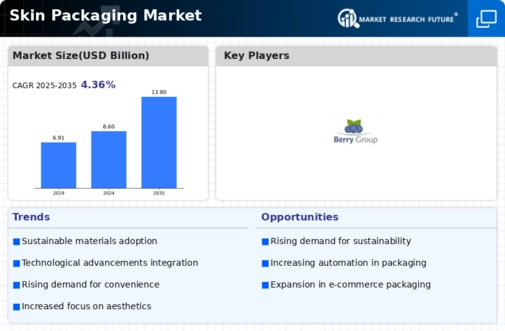Leading market players are investing heavily in research and development in order to expand their product lines, which will help the Skin Packaging Market, grow even more. Market participants are also undertaking a variety of strategic activities to expand their footprint, with important market developments including new product launches, contractual agreements, mergers and acquisitions, higher investments, and collaboration with other organizations. To expand and survive in a more competitive and rising market climate, Skin Packagingindustry must offer cost-effective items.
Manufacturing locally to minimize operational costs is one of the key business tactics used by manufacturers in the Skin Packaging industry to benefit clients and increase the market sector. In recent years, the Skin Packaging industry has offered some of the most significant advantages to medicine. Major players in the Skin Packaging Market, including Bemis Company Inc (U S), Berry Group, Inc. (U.S.), LINPAC Packaging Limited (U K. Sealed Air Corporation (U S.) and others, are attempting to increase market demand by investing in research and development operations.
Berry , Inc. is a Fortune 500 manufacturer and marketer of plastic packaging goods. It was formerly known as Berry Plastics Group, Inc. It is headquartered in Evansville, Indiana, and has over 265 sites and 46,000 employees worldwide.[3] In Fortune Magazine's rating, the corporation is one of the largest Indiana-based companies, with revenues of $14 billion or more in fiscal year 2022.[4] In 2017, the company's name was changed from Berry Plastics to Berry . March 2022, Berry Group collaborated with Koa to create Body Cleanser and Body Moisturiser bottles made entirely of recycled plastic.
Berry, as an industry leader in sustainability, focuses on reducing environmental impact through streamlined processes, continuously engaged partners, and optimised goods, a vision shared by Koa. Because of their shared objective for sustainability in packaging, Koa chose Berry as their supplier for this project.
Anuga FoodTec is a food and beverage sector trade show. It discusses process technology, filling and packaging technology, packaging materials, ingredients and food safety, and food production. Food processing, food packaging, safety and analytics, digitalisation, automation, intralogistics, environment and energy, science and pioneering are the eight product segments. Cologne hosts the fair every three years. Koelnmesse organises the event, which is supported by the Deutsche Landwirtschafts-Gesellschaft e.V. (German Agricultural Society). In April 2022, Mondi showcased new food packaging alternatives at Anuga FoodTec in Cologne, Germany. Two-tray packaging products offer recyclable options to fresh food producers, hence minimising food waste.
PerFORMing Monoloop and Mono Formable PP will provide high-barrier food protection, demonstrating the critical role that packaging plays throughout the supply chain.Amcor Plc has developed PowerPostTM technology that can create a bottle of up to 30% lighter made from 100% recycled material. It is designed for hot-filled beverages and prevents spills from overflowing. Additionally, it’s built on vacuum-absorbing technology PowerStrap.













Leave a Comment